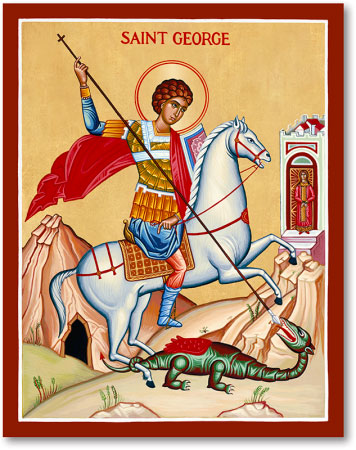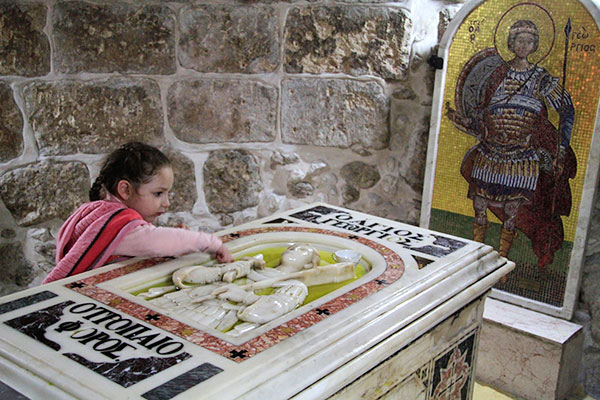
Venerated as a beloved protector of Christians since ancient times, Saint George is the patron saint of England, Greece, Russian, Portugal, and Palestine, and of course Georgia. His miraculous and prompt responses to the prayers of Christians in need earned him the title "the Quick to Hear" among Orthodox Christians, and, more simply, "the Great." There are over 200 churches in Egypt named after him. His feast day is April 23rd.
Other than his legendary battle with the dragon, few Christians know much about his life and heroic testimony for the Christian faith.
Born of Christian parents in Cappadocia (present-day Turkey) in the third century, he rose to the rank of tribune in the Roman army. When the Emperor Diocletian issued his edict expelling all Christian soldiers from the army and forcing all Roman soldiers to make sacrifice to the pagan gods, Saint George denounced the edict in front of his fellow soldiers and tore it up. He liberated his slaves, distributed his wealth and prepared for martyrdom. Unable to persuade the saint by promises of wealth and land, the Emperor had him imprisoned and tortured, and then dragged through the streets to be beheaded. His example so inspired the Emperor's wife that she too professed Christ and traded her earthly crown for the crown of martyrdom.
What about the dragon?
The story of Saint George and the dragon was first popularized by the Crusaders, who heard it from Orthodox Christians during their travels in the Middle East. Passing by the city of Silene in Libya, Saint George learned about a dragon, described as a winged crocodile, that was harming the city. To protect themselves from harm the townspeople fed the dragon with a daily offering of two sheep.

The existence of such a beast is not necessarily the stuff of myth and Tolkien. The Latin and Greek words from which we get "dragon" refer to any great serpent. And even in our own times humans have been threatened and even eaten by large serpents or crocodiles.
When the dragon's appetite was not satiated, the people of the city began sacrificing human beings to it, chosen by lot. At the time of Saint George's visit the lot had fallen to a local princess. Invoking the aid of Christ, Saint George vanquished the beast and freed the princess. His conquest of the dragon stands as an archetype for courage and victory in the battle against evil.
Saint George willed his estate to the Church in Jerusalem. In our own times, the wine used by the patriarch of Jerusalem is made exclusively from the grapes of Saint George's vineyard. Pilgrims in the Holy Land can visit the Church of Saint George at Lydda in Palestine, which houses the saint's relics and the chains with which he was bound, which are said to free afflicted souls from demonic possession.

A young girl venerates the tomb of Saint George in Palestine.